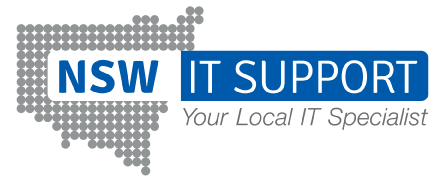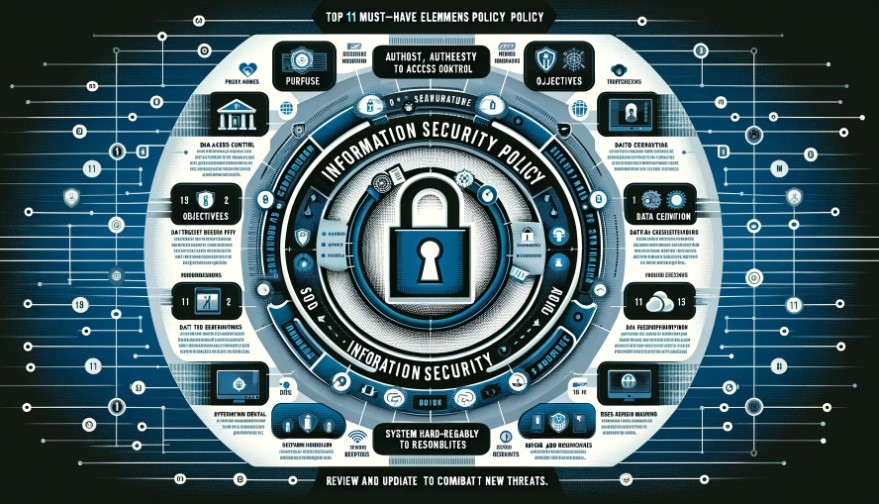In an era dominated by digital advancements, security concerns are an unfortunate part of running a business. According to Sophos, ransomware affected 66% of organisations in 2023. Thus, your business needs a strict, all-encompassing information security policy to deal with these issues. However, as you develop your policy, you must incorporate the necessary basic parts to provide the clarity, authority, and scope required for effectiveness.
This blog discusses the main elements of information security management to help your company achieve its data security objectives.
What is an Information Security Policy (ISP)?
Information Security Policy is defined as a system of rules, policies, and processes for employees and related parties that are intended to assist an organisation in protecting its data and supporting information technology, including components such as servers, networks, and applications based on the principles of confidentiality, integrity, and availability.
What are the key elements of the Information Security Policy?
A security policy may be as extensive as you desire, covering everything from IT security to the security of physical assets, but it must be comprehensive in scope. When developing information security laws, the following elements should be considered:-
Purpose
Security Program policies are useful strategies that outline the goals and scope that should contain the following:
- Create an extensive approach to information security that includes touch standards, security criteria, and best practices implemented by an organisation.
- Detect and respond to information security breaches of this policy caused by third-party suppliers and the misuse of networks, data, applications, computer systems, and mobile devices.
- Protect the organisation’s reputation while adhering to ethical and legal responsibilities as well as relevant governance.
- Protect client data and respond to requests and complaints regarding noncompliance with security requirements and data protection.
Audience
It specifies who the information security policy applies to and who it does not. You may also declare that third-party providers are not included in your information security laws.
Information Security Objectives
It helps your management team to agree on well-defined security strategy goals. The following are the three main aspects of managing information security:
Confidentiality
Data and information assets can only be accessed by authenticated and authorised users.
Integrity
Data must remain accurate, complete, and undamaged, and IT systems must remain operating.
Availability
Systems for IT, data, and information are accessible as needed.
Authority and access control
Hierarchical pattern
The decision of what data can be shared and with whom can be made by a senior manager. Different phrases may apply to a senior manager, junior employee, or contractor under the appropriate security regulations. The policy must specify each organisational role’s level of authority over data and IT systems.
Network security policy
Critical patching and other mitigating strategies are approved and implemented. Users can only access company networks and servers by using special logins that need authentication, such as strong password requirements, biometrics, ID cards, or tokens. As a result, you should keep track of all systems and login attempts.
Data classification
It is an excellent practice that helps organisations avoid intentional or unintentional disclosure. Thus, information security laws should be divided into the following categories:
Level 1: Publicly available information.
Level 2: Information that is designed to remain confidential but would not cause substantial harm if made public.
Level 3: Information that could bring harm to your organisation or your clients if it becomes public.
Level 4: Information that may cause substantial harm to your organisation or your clients if it becomes public.
Level 5: Information that would surely cause significant harm to your organisation or your clients if it became public.
Data support and operations
Three components of measures to protect all levels of data are :
Data protection regulations
Organisational standards and best practices, industry compliance requirements, and relevant regulations must all be used for protecting companies that handle or hold sensitive or personal data. Data encryption, incident response plans, backup and recovery procedures, firewalls, anti-malware software, password management, and defence against insider threats are all required by a wide range of security standards.
Data backup requirements
Organisations should create secure data backups. Ensure to encrypt the backups and securely store the backup media. Utilising secure cloud storage for storing backup data is a highly reliable option.
Data movement
Organisations must prioritise data security measures during data transfers. Use security protocols when moving data and apply encryption to any information transferred to portable devices or transmitted through insecure networks.
Data encryption
Whether the data is deployed in the cloud or on-premise, it is transported electronically. You can use end-to-end security methods, such as:
AES (Advanced Encryption Standard)
- To protect online data transfers. It is a common encryption technique that encrypts and decrypts using the same key.
- AES encryption keys come in three lengths i.e., AES-128, AES-192, AES-256. AES-256 is the strongest of them due to the large number of possible key combinations.
TLS (Transport Layer Security)
- To transport data securely using HTTPS. This method primarily uses encryption to secure email, payment card information, messaging, and VOIP.
Data backup
A complete backup and business contingency plan is needed to ensure data integrity and retrieval of information in the case of an emergency. This can be achieved by:
- Create as many backups as necessary. You can do it either manually or automatically.
- Encrypt your data while backing up.
- Monitor the backup data, keep track of changes, and keep an audit record.
Security awareness and behaviour
Organisations must develop strategies to increase information security awareness and prevent data breaches. It may be necessary to encourage specific employees to increase awareness and thwart attacks and losses.
One of the most effective ways to accomplish this is to thoroughly train your staff on your information handling. Ensure employees understand and are comfortable with your sensitive data information, data protection strategies, and access to information and systems.
To increase security awareness and promote responsible behaviour, you should incorporate the following components into your security training:
Social engineering
Educate staff members about the dangers of phishing emails and other social engineering attempts. Provide enough training to your staff so they can recognise, stop, and avoid attacks that involve things like these, and make them responsible for doing so regularly.
A clean desk policy
One of the simplest methods to avoid data loss is to keep sensitive information out of sight and access. Consider adopting a company-wide clean desk policy to achieve this goal. Instruct your employees to keep unsecured things off their desks and work locations. Strategies include filing and destroying old papers, rapidly removing printouts from printer areas, and employing cable locks to secure computers in workplaces.
Internet use policy
Consider setting strict internet use regulations as well. Depending on the sensitivity of your data and the needs of your business, you may want to block information-sharing websites such as YouTube, Facebook, and other social networking platforms. You can also use a proxy to prevent unauthorised website access and protect your data.
System hardening benchmarks
Relevant information security policies should include references to the organisation’s security benchmarks for hardening mission-critical systems, such as CIS (Centre for Information Security) benchmarks for Linux, Windows servers, AWS, Kubernetes, and others.
Roles and responsibilities of personnel
The last section of your information security policy should describe the obligations, rights, and duties of your employees about data protection. Assign responsibilities to your staff by giving tasks to carry out access reviews, train other staff members, supervise change management procedures, address issues, and offer general oversight and assistance with the implementation of the information security framework.
Make sure you explicitly outline the roles and responsibilities of your workers and let them know about their rights and authorisations. By compliance with this policy, you may assist your company in avoiding data management mistakes that could lead to security issues.
What is the importance of Information Security Policy?
Establishing an Information Security management system aims to:
- Establish a well-documented and managed program to ensure the security of the organisation’s information.
- Implement a scalable and continuing method for managing information and data.
- Meet the organisation’s data safety policy by raising awareness among workers and contractors about the best practices to follow.
- Ensure that individuals are adhering to the IT management policy by adopting security controls.
- Meet all compliance and regulatory standards.
Read more: Top 10 IT (Information Technology) Security Policies That Your Company Should Have?
Conclusion
An appropriate information security policy is a necessary component for an organisation to meet its business goals. By applying the main components outlined in this blog, such as data classification, access control, encryption, and backup, you can protect your confidential data from cyber threats and ensure that your organisation is ready for any cyber security incident. It is necessary to review and update your policy regularly to reflect changes in technology and the latest security threats. You can also protect your business information and reputation by giving priority to information security techniques and following best practices.










